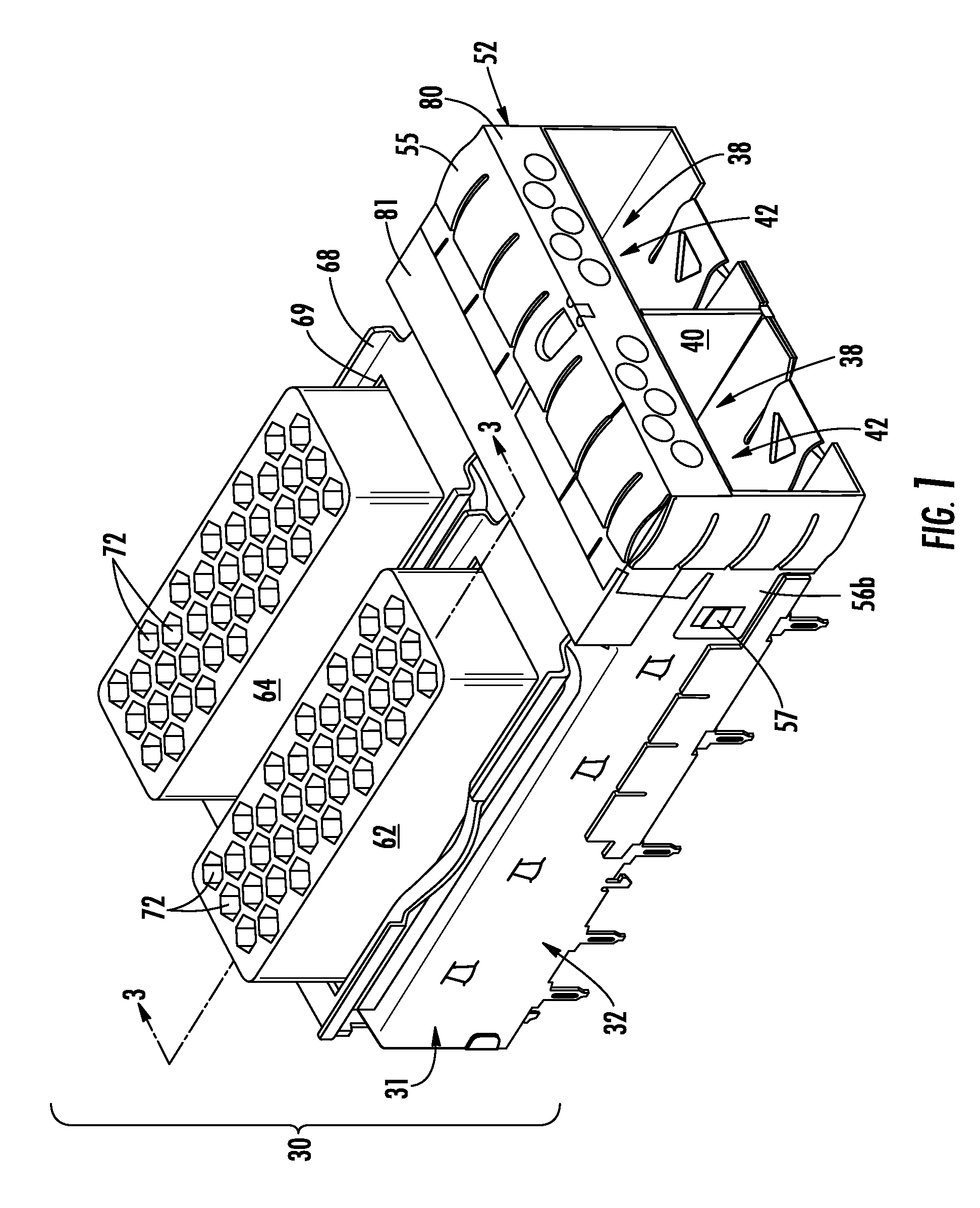Heat dissipative air guide
a technology of air guide and heat dissipation air, which is applied in the direction of ventilation panels with screening provisions, cooling/ventilation/heating modifications, and screening casings. it can solve the problems of poor airflow conditions, insufficient airflow, and crowded placement of electronic modules on the motherboard of the device, so as to increase the rate of thermal transfer
- Summary
- Abstract
- Description
- Claims
- Application Information
AI Technical Summary
Benefits of technology
Problems solved by technology
Method used
Image
Examples
second embodiment
[0050]FIGS. 6-8 illustrate a heat dissipative air guide constructed in accordance with the principles of the Present Disclosure. A shielding cage assembly 100 is shown with two module-receiving bays 102. The shielding cage body 104 has first and second openings 105, 106 disposed on a top wall 108 of the cage body 104. The first openings 105 communicate with the bottoms of the two thermal transfer members 110, 112. One of the thermal transfer members 110 of this embodiment extends partially into the interior of its respective module-receiving bay 102. Second openings 106 of the cage body 104 are disposed underneath and adjacent to an air guide 114 that extends transversely with respect to the module-receiving bays 102 and of the two thermal transfer members 110, 112. The thermal transfer members 110, 112 of this embodiment each have a lower base portion 116 which contains a plurality of air exit passages 72 and each thermal transfer member 110, 112 further includes upper portions 117...
third embodiment
[0053]FIGS. 9-13A illustrate a heat dissipative air guide 200 constructed in accordance with the principles of the Present Disclosure and suitable for use with a 1×2 ganged shielding cage 201. In this embodiment, both the two thermal transfer members 209a, 209b and the air guide 206 are formed as an integrated, single assembly 204 that extends across almost the entire top wall 44 of the shielding cage 201. In the illustrated embodiment, the assembly 204 is formed as a single piece and may be die cast as such. Alternatively, it is contemplated that the assembly 204 may be injection molded, or formed in another way. The assembly 204 may also include separate thermal transfer members and an air guide, as shown above, that are held together such as by fasteners, dowels, adhesives and other suitable means. The assembly 201 preferably has a stepped profile when viewed from the side with the air guide portion 206 thereof being disposed lower than the thermal transfer portion 208.
[0054]The ...
fifth embodiment
[0057]FIGS. 16-20 illustrates a shielding cage-air guide assembly 500 constructed in accordance with the principles of the Present Disclosure. This assembly 500 includes a shielding cage assembly 502 that houses a plurality of electrical connectors 503 of the dual stack style, which include a pair of vertically spaced-apart receptacles in the form of card slots 504 which are housed in individual module-receiving bays 509. The module-receiving bays 509 are arranged in a 2×4 ganged arrangement and mounted to a circuit board 506. That is, the shielding cage assembly 502 includes two rows of four module-receiving bays 509, each of which is intended to receive an electronic module therein to mate with a respective receptacle connector 503. Each pair of module-receiving bays 509 in the vertical direction are separated by an intervening spacer portion 515 that defines a longitudinal hollow space therebetween.
[0058]A pair of air guides 516, 518 are provided and are disposed on the top and b...
PUM
 Login to View More
Login to View More Abstract
Description
Claims
Application Information
 Login to View More
Login to View More - R&D
- Intellectual Property
- Life Sciences
- Materials
- Tech Scout
- Unparalleled Data Quality
- Higher Quality Content
- 60% Fewer Hallucinations
Browse by: Latest US Patents, China's latest patents, Technical Efficacy Thesaurus, Application Domain, Technology Topic, Popular Technical Reports.
© 2025 PatSnap. All rights reserved.Legal|Privacy policy|Modern Slavery Act Transparency Statement|Sitemap|About US| Contact US: help@patsnap.com



